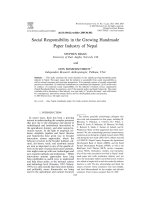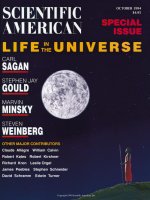Project Gutenberg''''s Social Life in the Insect World, by J. H. Fabre pdf
Bạn đang xem bản rút gọn của tài liệu. Xem và tải ngay bản đầy đủ của tài liệu tại đây (2.43 MB, 829 trang )
Project Gutenberg's Social Life in the
Insect World, by J. H. Fabre
This eBook is for the use of anyone
anywhere at no cost and with
almost no restrictions whatsoever. You may
copy it, give it away or
re-use it under the terms of the Project
Gutenberg License included
with this eBook or online at
www.gutenberg.org
Title: Social Life in the Insect World
Author: J. H. Fabre
Translator: Bernard Miall
Release Date: May 8, 2006 [EBook #18350]
Language: English
*** START OF THIS PROJECT GUTENBERG EBOOK
SOCIAL LIFE IN THE INSECT WORLD ***
Produced by Louise Pryor, Janet
Blenkinship and the Online
Distributed Proofreading Team at
SOCIAL LIFE
IN THE INSECT
WORLD
BY
J. H. FABRE
Translated by
BERNARD MIALL
WITH 14 ILLUSTRATIONS
LONDON
T. FISHER UNWIN, LTD.
ADELPHI TERRACE
First Edition 1911
Second Impression 1912
Third Impression 1912
Fourth Impression 1913
Fifth Impression 1913
Sixth Impression 1915
Seventh Impression 1916
Eighth Impression 1916
Ninth Impression 1917
Tenth Impression 1918
Eleventh Impression 1918
Twelfth Impression 1919
(All rights reserved)
FEMALES.
2. THE MANTIS DEVOURING A
CRICKET.
3. THE MANTIS DEVOURING HER
MATE.
4. THE MANTIS IN HER ATTITUDE
OF PRAYER.
5. THE MANTIS IN HER
"SPECTRAL" ATTITUDE.
(See p. 76.)
CONTENTS
CHAPTER I—THE FABLE OF THE
CIGALE AND THE ANT
CHAPTER II—THE CIGALE LEAVES
ITS BURROW
CHAPTER III—THE SONG OF THE
CIGALE
CHAPTER IV—THE CIGALE. THE
EGGS AND THEIR HATCHING
CHAPTER V—THE MANTIS. THE
CHASE
CHAPTER VI—THE MANTIS.
COURTSHIP
CHAPTER VII—THE MANTIS. THE
NEST
CHAPTER VIII—THE GOLDEN
GARDENER. ITS NUTRIMENT
CHAPTER IX—THE GOLDEN
GARDENER. COURTSHIP
CHAPTER X—THE FIELD CRICKET
CHAPTER XI—THE ITALIAN
CRICKET
CHAPTER XII—THE SISYPHUS
BEETLE. THE INSTINCT OF
PATERNITY
CHAPTER XIII—A BEE-HUNTER:
THE PHILANTHUS AVIPORUS
CHAPTER XIV—THE GREAT
PEACOCK, OR EMPEROR MOTH
CHAPTER XV—THE OAK EGGAR,
OR BANDED MONK
CHAPTER XVI—A TRUFFLE-
HUNTER: THE BOLBOCERAS
GALLICUS
CHAPTER XVII—THE ELEPHANT-
BEETLE
CHAPTER XVIII—THE PEA-WEEVIL
CHAPTER XIX—AN INVADER: THE
HARICOT-WEEVIL
CHAPTER XX—THE GREY LOCUST
CHAPTER XXI—THE PINE-CHAFER
INDEX
ILLUSTRATIONS
THE MANTIS: A DUEL
BETWEEN FEMALES;
DEVOURING
A CRICKET;
DEVOURING HER MATE;
IN HER ATTITUDE
OF PRAYER; IN HER
"SPECTRAL" ATTITUDE
Frontispiece
DURING THE
DROUGHTS OF SUMMER
THIRSTING INSECTS,
AND NOTABLY THE
ANT, FLOCK TO THE
DRINKING-PLACES
OF THE CIGALE 8
THE CIGALE AND THE
EMPTY PUPA-SKIN
28
THE ADULT CIGALE,
FROM BELOW. THE
CIGALE OF
THE FLOWERING ASH,
MALE AND FEMALE
36
THE CIGALE LAYING
HER EGGS. THE GREEN
GRASSHOPPER,
THE FALSE CIGALE OF
THE NORTH,
DEVOURING THE TRUE
CIGALE, A DWELLER IN
THE SOUTH 48
THE NEST OF THE
PRAYING MANTIS;
TRANSVERSE SECTION
OF THE SAME; NEST OF
EMPUSA PAUPERATA;
TRANSVERSE SECTION
OF THE SAME;
VERTICAL
SECTION OF THE SAME;
NEST OF THE GREY
MANTIS;
SCHEFFER'S SISYPHUS
(see Chap. XII.); PELLET
OF
THE SISYPHUS; PELLET
OF THE SISYPHUS,
WITH
DEJECTA OF THE
LARVA FORCED
THROUGH THE
WALLS 88
THE MANTIS
DEVOURING THE MALE
IN THE ACT OF
MATING; THE MANTIS
COMPLETING HER
NEST;
GOLDEN SCARABÆI
CUTTING UP A LOB-
WORM
90
THE GOLDEN
GARDENER: THE
MATING SEASON OVER,
THE MALES ARE
EVISCERATED BY THE
FEMALES
114
THE FIELD-CRICKET: A
DUEL BETWEEN
RIVALS; THE
DEFEATED RIVAL
RETIRES, INSULTED BY
THE
VICTOR 124
THE ITALIAN CRICKET 132
THE GREAT PEACOCK
OR EMPEROR MOTH 180
THE GREAT PEACOCK
MOTH. THE PILGRIMS
DIVERTED
BY THE LIGHT OF A
LAMP
196
THE GREY LOCUST; THE
NERVATURES OF THE
WING;
THE BALANINUS
FALLEN A VICTIM TO
THE LENGTH
OF HER PROBOSCIS 244
THE PINE-CHAFER
(MELOLONTHA FULLO) 318
SOCIAL LIFE IN
THE INSECT
WORLD
CHAPTER I
THE FABLE OF THE
CIGALE AND THE ANT
Fame is the daughter of Legend. In the
world of creatures, as in the world of
men, the story precedes and outlives
history. There are many instances of the
fact that if an insect attract our attention
for this reason or that, it is given a place
in those legends of the people whose last
care is truth.
For example, who is there that does not, at
least by hearsay, know the Cigale? Where
in the entomological world shall we find a
more famous reputation? Her fame as an
impassioned singer, careless of the future,
was the subject of our earliest lessons in
repetition. In short, easily remembered
lines of verse, we learned how she was
destitute when the winter winds arrived,
and how she went begging for food to the
Ant, her neighbour. A poor welcome she
received, the would-be borrower!—a
welcome that has become proverbial, and
her chief title to celebrity. The petty
malice of the two short lines—
Vous chantiez! j'en suis bien aise,
Eh bien, dansez maintenant!
has done more to immortalise the insect
than her skill as a musician. "You sang! I
am very glad to hear it! Now you can
dance!" The words lodge in the childish
memory, never to be forgotten. To most
Englishmen—to most Frenchmen even—
the song of the Cigale is unknown, for she
dwells in the country of the olive-tree; but
we all know of the treatment she received
at the hands of the Ant. On such trifles
does Fame depend! A legend of very
dubious value, its moral as bad as its
natural history; a nurse's tale whose only
merit is its brevity; such is the basis of a
reputation which will survive the wreck
of centuries no less surely than the tale of
Puss-in-Boots and of Little Red Riding-
Hood.
The child is the best guardian of tradition,
the great conservative. Custom and
tradition become indestructible when
confided to the archives of his memory.
To the child we owe the celebrity of the
Cigale, of whose misfortunes he has
babbled during his first lessons in
recitation. It is he who will preserve for
future generations the absurd nonsense of
which the body of the fable is constructed;
the Cigale will always be hungry when the
cold comes, although there were never
Cigales in winter; she will always beg
alms in the shape of a few grains of wheat,
a diet absolutely incompatible with her
delicate capillary "tongue"; and in
desperation she will hunt for flies and
grubs, although she never eats.
Whom shall we hold responsible for these
strange mistakes? La Fontaine, who in
most of his fables charms us with his
exquisite fineness of observation, has here
been ill-inspired. His earlier subjects he
knew down to the ground: the Fox, the
Wolf, the Cat, the Stag, the Crow, the Rat,
the Ferret, and so many others, whose
actions and manners he describes with a
delightful precision of detail. These are
inhabitants of his own country;
neighbours, fellow-parishioners. Their
life, private and public, is lived under his
eyes; but the Cigale is a stranger to the
haunts of Jack Rabbit. La Fontaine had
never seen nor heard her. For him the
celebrated songstress was certainly a
grasshopper.
Grandville, whose pencil rivals the
author's pen, has fallen into the same
error. In his illustration to the fable we
see the Ant dressed like a busy housewife.
On her threshold, beside her full sacks of
wheat, she disdainfully turns her back
upon the would-be borrower, who holds
out her claw—pardon, her hand. With a
wide coachman's hat, a guitar under her
arm, and a skirt wrapped about her knees
by the gale, there stands the second
personage of the fable, the perfect portrait
of a grasshopper. Grandville knew no
more than La Fontaine of the true Cigale;
he has beautifully expressed the general
confusion.
But La Fontaine, in this abbreviated
history, is only the echo of another
fabulist. The legend of the Cigale and the
cold welcome of the Ant is as old as
selfishness: as old as the world. The
children of Athens, going to school with
their baskets of rush-work stuffed with
figs and olives, were already repeating the
story under their breath, as a lesson to be
repeated to the teacher. "In winter," they
used to say, "the Ants were putting their
damp food to dry in the sun. There came a
starving Cigale to beg from them. She
begged for a few grains. The greedy
misers replied: 'You sang in the summer,
now dance in the winter.'" This, although
somewhat more arid, is precisely La
Fontaine's story, and is contrary to the
facts.
Yet the story comes to us from Greece,
which is, like the South of France, the
home of the olive-tree and the Cigale.









